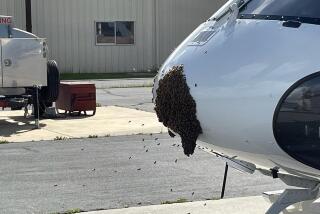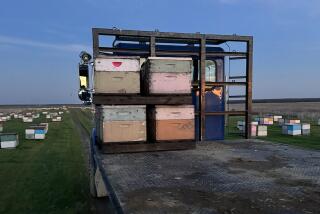Bees Relentless in March to U.S. : Scientists Look for Ways to Lessen Their Impact
- Share via
In their 29-year trek from Sao Paulo, Brazil, to Central America, Africanized honeybees have left a trail of destruction and, occasionally, death. They have displaced local bees, decimated the South American honey industry, destroyed thousands of wild and farm animals and killed at least 150 people.
Although the recently discovered colony in Kern County most probably represents an isolated outbreak, scientists say, it is only a matter of time before the bees arrive in force in the United States.
“It’s not economically feasible to stop them,” said Thomas Renderer of the U.S. Department of Agriculture’s bee breeding and stock center laboratory in Baton Rouge, La. “So we have to do one of two things. . . . We can try to change their behavior patterns so that we can get along with them, or we can try to find a way to maintain European honeybees as a separate and viable species.”
In fact, scientists are working very hard to achieve both goals, although with only limited success so far.
The bees that are now making their way north are derived from African honeybees imported into Brazil in 1956 by Warwick Kerr, a geneticist at a Sao Paulo university. He hoped to crossbreed the African bees, which forage farther from their hives and work longer hours than their European brethren, with European bees to obtain a hybrid that would be unusually industrious and still produce large amounts of honey.
Physically, the African bees differ only slightly from the European bees. “They are a little smaller and a little darker,” Renderer said. They are so similar, in fact, that scientists can tell them apart only by measuring many different parts of their anatomy and performing a statistical analysis.
The Africanized bees also have slightly different tastes. They do not feed on nectar from many commercially important plants, such as tomatoes, and drive away bees that do. It is this trait that presents a threat to U.S. agriculture, which is highly dependent on bee pollination.
Difference in Temperament
Even more pronounced is the difference in temperament. The African bees and their descendants “have a highly variable defense behavior,” said entomologist Orley R. Taylor of the University of Kansas at Lawrence. “Sometimes you can kick them or run over them with a truck, and they won’t do anything. Other times, they will respond to a disturbance with incredible ferocity.”
That ferocity has earned them the title “killer bees.” Individually, however, they are no more dangerous than European bees. Their venom is exactly the same, and they may even produce slightly less of it. It is the propensity to attack in force that makes them dangerous.
Kerr hoped a hybrid would be less vicious. Before he could produce a tamer bee, however, 26 queens and their accompanying swarms escaped from his apiary and took up residence in the surrounding countryside. Within six years, they had occupied a zone around Sao Paulo with a diameter of 600 miles. They then started moving northward at a rate of 200 miles to 300 miles per year.
70 Deaths in Venezuela
The bees quickly reached Venezuela, and within three years of their arrival, 70 deaths from multiple bee stings had been reported. Hundreds of farm animals that were penned and could not flee the bees were also killed.
The bees also destroyed Venezuela’s honey industry. Africanized bees convert a much higher proportion of their honey into food for the hive, leaving less for the beekeeper. In 1975, that country had produced 13 million pounds of honey per year. By 1981, the U.S. Department of Agriculture says, production had dropped to 200,000 pounds per year.
“As the bees continued northward, we noticed an interesting pattern,” Taylor said. “When the bees entered an area, the number of deaths and stinging incidents would increase for the first three years or so, then tail off. It may be that people and animals have learned to stay away from them, but it may also be that the bees become more acclimated to their environment. That would be a hopeful sign.”
The bees continued northward, moving 300 to 400 miles a year in dry, temperate regions they found hospitable, 200 miles or less a year in wetter and colder areas.
‘Moving Long Distances’
“The Africanized bees have a remarkable capability for moving long distances,” Taylor said. “There is conjecture, and some evidence, that they can travel as far as 100 miles in two weeks.”
Such long treks had been considered impossible for bees until Taylor and a graduate student discovered that the bees can make what amounts to a pit stop.
“The swarm will settle down periodically and send out foragers for nectar,” Taylor said. “When the foragers return, they fuel up the other bees, they swarm, and they fly off again.” European bees are not known to behave this way.
When the Africanized bees land in a region, they take it over fairly quickly. Sometimes an Africanized bee will physically push a European bee out of the way at a flower. In the longer term, however, they simply consume the lion’s share of local resources because their reproduction rate is two to three times as high.
The Africanized bees also mate with the local bees, but “a funny thing happens,” Taylor said. “The Africanized queens tend to mate with Africanized drones, and the European queens also mate with Africanized drones. The European drones are left out in the cold, so to speak.”
Africanized Traits Dominate
A single mating between an Africanized and a European bee normally produces a bee with African characteristics. Repeated fertilization by Africanized drones simply reinforces those traits.
It is not that the European drone has a poor personality or is physically unattractive to the queens. Instead, he seems to have bad timing.
“European bees tend to mate early in the afternoon, Africans later in the day,” Taylor said. “Furthermore, the queens tend to fly farther from the hive than the drones do so that they don’t mate with their brothers.”
When a region has been invaded by Africanized bees, then, the European queen flies away from the European drones and is more likely to encounter Africanized drones. In contrast, when the Africanized queen comes out to mate, most of the European drones have returned to the hive. The result is that the Africanized bees take over.
Taylor is trying to reverse this trend by breeding European drones that will breed later in the afternoon. They would thus be more likely to breed with the Africanized queens repeatedly, and European characteristics might predominate. Unfortunately, it will take several years to change the biological clocks of the drones.
Panama Canal No Barrier
Meanwhile, the bees continue their inexorable march. Some scientists thought the Panama Canal would stop them, but by 1983 they had leapfrogged across it. Today, the Africanized bees are firmly established in Honduras and El Salvador, and possibly in Guatemala.
Taylor said they will be in Mexico in the first six months of 1986, and in Brownsville, Tex., by the end of 1988 or early 1989.
Some scientists would like to make a last-ditch stand in Mexico, according to Richard Cowden of the U.S. Department of Agriculture’s animal and plant health inspection service. That would require establishing a 20-mile-wide zone across the narrow Isthmus of Tehuantepec through which the bees would not be allowed to pass. A similar technique has been used to halt the northward migration of the screwworm, whose maggots infest the wounds of cattle, and the Barooa mite, which is, ironically, a pest of honeybees.
Those pests can be controlled from the air, however. Large numbers of sterilized males are released from airplanes; these males outnumber the local males and females never get fertilized. This technique won’t work for bees.
Eradication would require large-scale spraying of insecticides and physical examination of every hive. “It’s simply too expensive,” Cowden said.
‘No Choice but to Coexist’
If the Africanized bees cannot be tamed before they reach the United States, USDA’s Renderer said, “we may have no choice but to coexist with them and try to keep the European bees as separate species.” He said he may have found a way to do this.
His scheme depends on the fact that bees have a rigid mating schedule. “Typically, a beekeeper will set out about 2,000 queen eggs at a given time,” he said. “Seven days later, the queens emerge and mate. Three days later, the keeper will check to see if they have laid eggs.”
Renderer’s strategy involves setting out a large number of specially designed traps to capture all of the Africanized drones on the day of their nuptial flight.
“In the small number of trials we’ve conducted,” Renderer said, “we’ve found that we can capture nearly all the Africanized drones pretty effectively. The European queens then mate with European drones, and the integrity of the species is maintained.”
He thinks this is preferable to trying to produce tamer hybrids. “I’ve worked intensively with the Africanized bees for seven years,” he said, “and my resounding conclusion is keep the European bees.”
More to Read
Sign up for Essential California
The most important California stories and recommendations in your inbox every morning.
You may occasionally receive promotional content from the Los Angeles Times.













